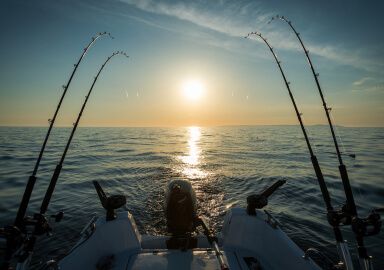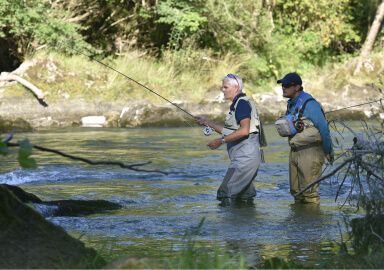Tigerfish
With a mouth full of sharp pointed teeth, and a habit of repeatedly jumping out of the water in order to dislodge the hook, the Tigerfish is undoubtedly the best known and most targeted freshwater game fish in Africa.
View 24 listings
24
listings
–
price starting from
10
countries
–
to the nearest trip
Where and When?
The best known destinations for Tigerfish fishing in southern Africa are around the Zambezi and Limpopo Rivers and the Okavango Delta in Botswana. Dam development has interrupted the natural flooding regime in many rivers, which affected Tigerfish spawning and reduced their numbers, and so did harvest for the market. In southern Africa Africa, however, there are now places fisheries are, to a greater or lesser degree, managed and many fishing lodges and resorts are sited to facilitate game fishing for Tigerfish. The best time for African Tigerfish is summer, as in the colder months they don’t feed as aggressively and stick to deeper waters. The best fishing is usually not during the heat of the day but in the mornings and afternoons. Loor for Tigerfish around the margins of dams, pans or lakes or in the shallows of large rivers. Home grown knowledge is extremely important and obtaining a local or specialist guide will usually markedly increase your chances of success, especially with trophy fish.
About Tigerfish
Most fishing experts agree that the African Tigerfish is in a class by itself. The most conspicuous feature of its appearance is the mouth, which displays a mass of sharp pointed teeth, with very little soft flesh around it. They are warm water breeders, with spawning usually taking place during summer flooding; countless eggs are laid, but the young require a cover of vegetation to survive. Tiger fish thrive in well-oxygenated waters. Few fish anywhere in the world can compare with the rapacious appetite and aggressive feeding of the African Tigerfish. There are confirmed records of them following flying swallows and then leaping out of the water into the air and successfully catching them. The current angling record in South Africa is about 6 kg, but in Zimbabwe the Tigerfish can be as big as 15 kg in weight. Tigerfish is tasty, but bony, so most sports anglers practice catch-and-release.
How to Catch?
Tigerfish are a predatory species that can be caught on almost any artificial lure as well as live or dead baits. Fish filets, both on a bottom fishing rig, and trolled at a high speed across the surface, are preferred by many guides. Natural baits tend to work better in the winter, and artificial lures in the warmer months. Flyfishing can elicit many strikes but actually hooking and landing a Tigerfish on a light rod is a whole different story. You shouldn’t expect the Tigerfish to set the hook by itself; it’s important to be on the alert and set it as soon as you feel the strike. Be ready for an explosive reply! This species’ teeth are extremely sharp and can easily cut through even strong nylon, but wire traces also have their drawback: the Tigerfish has excellent vision and may spot them.








